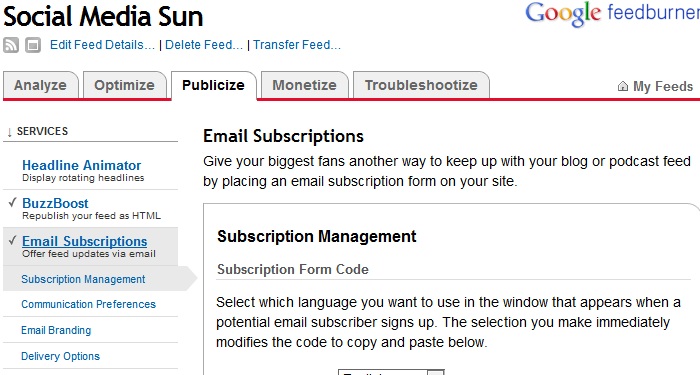 One of the great things about running a website, blog, or social media campaign is that there is an abundance of data and statistics to measure your performance. Hundreds of metrics are measured daily by social networks, your own host, and third parties whether you ask them to or not.
One of the great things about running a website, blog, or social media campaign is that there is an abundance of data and statistics to measure your performance. Hundreds of metrics are measured daily by social networks, your own host, and third parties whether you ask them to or not.
Users will compare publicly listed statistics such as re-tweets, Facebook likes, Alexa rank and even your Klout score with other bloggers to try and determine where you stand. While most of those stats rate somewhere between worthless and unreliable as a performance indicator, there are statistics that will adequately measure your success and ultimately correlate with performance.
Statisticians consider all of these metrics to be performance indicators, and there isn’t any reason not to track your progress when it comes to page views, re-tweets or followers. However a handful of performance indicators will correlate to your bottom line and others will help factor out false positives and noise that come along with social media and web traffic. When you notice a definite relationship between certain statistics and your bottom line they become key performance indicators, and should be considered more carefully during analysis.
Here are 5 metrics that rise above the rest when it comes to social media and blog analytics, and are often the best performance indicators that most blogs and websites have in common.
RSS Subscribers (Email)
There really isn’t a way to know for sure how many people read your posts in their entirety every day. Users may lose interest, get distracted, click on another link on the page or any number of things that diverts their attention. If you have an RSS feed however, you do know how many people decided that your blog posts were valuable enough to warrant daily reading. The problem with RSS subscribers is that many readers will create a feed aggregator account with the best intentions, only to rarely or never check in to see what’s good.

If you use Feedburner, you can set up and track your e-mail subscriptions by accessing the publicize tab, and then select Email Subscriptions.
A segment of RSS subscribers however will get your posts sent directly to their e-mail. E-mail is one of the last private outposts on the Internet, and most people reserve their e-mail addresses for only the most important communications. When a reader gives you access to their e-mail, it’s almost telling you that they want reminded every day to visit your blog. Some readers may never open the e-mails once they’re sent, but you can rest assured that you are getting those impressions every day, whether they read the posts or not, and the sentiment attached to giving you that access is what some people would call ‘brand loyalty’.
If you would like to receive Social Media Sun in your e-mail every weekday, sign up through our RSS feed!
Twitter Listed
One of the most used metrics for comparing the popularity of two people online is Twitter Followers. When someone has 100,000 followers, people immediately assume that others had a reason to follow them. The truth is that Twitter followers are a dime a dozen… literally. They can be bought in bulk, and can be scammed with auto-follow software. Several sources have estimated that nearly half of all Twitter accounts are either entirely automated, or used to pad follower numbers.
While every follower may not even be a real human, one statistic that hasn’t been targeted for inflation by cheaters is the number of times your account has been “listed”. When someone lists you, it is the same as acknowledging your role. Sometimes there isn’t much thought that goes into a listing, but for the most part you’ll be listed by category for what your tweets pertain to, and that means the user knows enough about you to classify your profile.
Getting listed also makes your tweets more accessible because when a user is viewing that list you aren’t competing with as many other tweets. Lastly, you can logically assume that the person who listed you wants to view your tweets more often. Either way, it’s more valuable than a follow and as a method of comparing users it’s far more accurate.
During Twitter’s last redesign they removed the stat from users’ profile pages. You can still see the lists you’ve been added to, but I haven’t been able to find a total and adding up hundreds or thousands of instances isn’t feasible. Prior to writing this article I thought I had saw the stat recorded on one of the several Twitter grading websites, but after looking for several hours I was unable to find it again. If there is an app or program that displays the number of times each user is listed, please tell us in the comments! If there isn’t currently, the stat is so valuable that an app or program will no doubt add it as a feature in the near future. This is one of those instances where I need YOUR help!
Facebook – Talking About This
Almost every brand has a Facebook page these days. It’s an important place to be because no matter what your business is, your customers are there. The public meter of a Facebook page’s success has been likes and activity on page for a long time. Since the advent of Timeline, Facebook now publishes a key statistic that can tell you how far your reach on Facebook really is: how many people are talking about your page.
Not all interactions regarding your brand will be confined to your Facebook page. Followers will sometimes spread your message far and wide, and your brand will often be brought over from news articles, industry blogs, and even other social networks. Keep in mind that people talking about your page isn’t always positive, but the sentiment is usually easy to gauge by snooping around a little. If you have a strong presence on Facebook, negative comments will usually be brought in front of you, so if you haven’t heard about it, people talking about your brand is most likely positive.

The Talking About This stat is now displayed right next to the number of Likes on every Facebook Page.
This statistic can be inaccurate, but not because the page owner has artificially inflated the numbers like they can with Facebook likes. Algorithms aren’t capable of making judgment calls, and if 120 people are talking about Adam Justice, they could be talking about anyone named Adam Justice. With a Facebook campaign, you’re going to get diminishing returns on your likes. Older likes may have come from user that are no longer active on Facebook, or have no reason to visit your page (I may like Ford’s Facebook page when I am looking to buy a car, but after I make the purchase I may not care for another 10 years), so knowing how many people are currently talking about you is a far more accurate measure of your amplification than how many likes you’ve been able to accumulate over the life of your page.
Time on Site
I admit to having the bad habit of checking my Google analytics account too often. I like to see how many page views we’re getting each day, and how we’re doing compared to last month. The thing is, page views fluctuate with the content, and they’re more valuable for some websites than others. Actually, some page views are more valuable for your own site than other page views, so hits alone hardly ever correlate with your success. To separate the valuable visitors from drive by visitors and casual surfers, look at how long they spend on your site.
It would be nice if every visitor quickly turned into a profit, but the fact is that real people are harder to separate from their money than that. I learned as a salesman that if someone is listening intently to what you’re telling them, you’ve already got your sale – you just need to close it. With a website, prolonged views could mean that visitors are interacting in your comments, viewing more than one page, considering a purchase or at the very least deeply interested in your content. Whatever the reason, prolonged visits are always a positive. Improving your time on site stats is a goal that every webmaster and blogger should share. The longer someone is on your site, the more likely they are to pull the trigger with you, and the less time they’re spending with your competitors.
Alexa Rank
Unless you’re sharing your analytics publicly, the average web surfer doesn’t know for sure if you have a few thousand or a hundred thousand visitors each day. There are websites that estimate page views, but they’re highly unreliable in the majority of cases, and I’ve come across instances where data is missing entirely.
The most accurate resource for third party analytics is Alexa, and that’s where other developers and venture capitalists will go when they want a solid number on your site’s current status. Alexa doesn’t publish how many hits you have, but they do rank your site in relation to other sites, and offer several important insights. Your Alexa rank isn’t that important to you; you know exactly how well your website is doing, and at the end of the day the most important competition is yourself. It is however important for public perception, so it’s important to know exactly where you stand with them. When a possible advertiser, investor, or venture capitalist wants to discuss opportunities, Alexa will be their first stop for information, and it can aid you by knowing how your site stacks up against their other partnerships.
Bottom Line
People are going to judge you daily online if you have any public facing presence. They notice how many times your last post was re-tweeted, how many comments it had, and how many people are following you. You’ll be tracking your own progress through unique visitors, page views, market share and Re-Tweets. Upward trends are almost always positive, but judging your success with every metric in the world will not give you a clear picture.
Even though the stats I’ve covered are seemingly important, they aren’t going to tell you much more by themselves. The one thing they have in common is that they are slightly harder to manipulate, or are manipulated less often than other metrics and that they indicate a deeper engagement.
If you’re online to make money, the end to it all is going to be your pocket book. The profit that you net will be the most telling statistic of them all. There are lots of people who maintain an online presence however that won’t be able to judge their success with dollars and cents. Tumblr is a classic example; the blogging platform is wildly popular and considered extremely valuable. They’ve yet to make a cent through monetization though. Most technology startups will have similar life cycles. Whether the site is funded through investments or by a single individual, most websites will run for a while to test the waters and develop a fan base before monetizing. Just because your website isn’t making tons of money doesn’t mean it’s worthless.
In addition to these stats, keep up your own analytics and try to find performance indicators that correlate to YOUR success. If you notice that time on site, subscribers, page views and social media engagement improves when your posts generate the most comments, concentrate on strategies that are related to improving that metric. If you’re lucky enough to have a bottom line as your end result, try to find out which metrics closely relate to your profits – or profit margins. If you’ve developed your website and online presence to target your ideal customers, these general performance indicators can be the most valuable insights available to help chart the course of your Internet marketing strategy.
What metrics do you consider important? Do all of your measurements seem to correlate, or do they follow confusing patterns that seem to be meaningless? Do you know which statistics are your key performance indicators?
- The Evolution of Marketing: From Catalogs to Cat Blogs - November 8, 2022
- How to Make a Tweet This Link - February 5, 2022
- Dramatically Improve Marketing Results with Advanced Analytics - September 20, 2021
- The Next Chapter for Social Media Sun - June 4, 2013
- Optimizing Your FAQ to Maximize ROI - December 5, 2012
- Blogging Isn’t a Rocket, It’s More Like a Roller Coaster - November 19, 2012
- Weapons of Influence and Klout’s Role in Marketing - November 17, 2012
- The Biggest Problem With Inbound Marketing Blogs Today - November 16, 2012

Thanks Adam! I’ll be checking out my stats…
Hi Adam, you can find the number of Twitter lists a Twitter user is included in using Tweetdeck. Click on the person’s name and you will pull up a screen that shows metrics including the number of lists.
Not an expert, and not sure if it’s what you are asking, but (about lists) tweetcaster show me three options: mine, I follow and listed. Supposedly, the last gives me the list in which I have been included.